
When I was growing up dazed and confused in 1980s Australian suburbia, cultural binarism engulfed us like a plume of hairspray on a poodle perm.
Labor or Liberal, male or female, Coke or Pepsi, Summer Bay or Ramsay Street… there was no middle ground and tough titties if you didn’t fit in. Or, worse still, refused to.
Such black-and-white thinking even applied to the family transport tucked away behind the B&D roller door. Local or imported. Holden or Ford. Cars or 4WDs.
Except for Subarus, the latter were universally ladder-frame off-roaders with names like LandCruiser, Patrol and Pajero, but began splintering off into cheaper pick-up-derived wagons during the decade, led by the HiLux-based 4Runner. Then somebody created a car that looked like a 4WD, the world went crazy for SUVs and here we are today. Choice, glorious choice.
Evolution is the enemy of binary thinking.

Yet, like the primordial reptiles of 300 million years ago, body-on-frame 4WDs survive. Strike that. They thrive, going forth where SUVs can’t tread, as off-road adventurers and holidaymakers alike snap ’em up. Demand for many far outstrips supply.
Australia’s favourite has long worn Prado badges, but now nudging $90K in Kardashian Kakadu guise, they’re getting a bit rich for many working-class Aussies. More like Toyota Prada!
This is where the smaller, cheaper Fortuner steps in. A latter-day 4Runner (which evolved into a larger and more sophisticated Prado-based 4WD for the USA decades ago), it was designed mainly for South East Asia and rides on the same, ageing low-cost ‘Innovative Multi-purpose Vehicle’ chassis as the last two HiLux generations.

Unusually for a Toyota, the gawky-looking Fortuner has underperformed since launching locally in late 2015, despite significant Aussie input, lagging behind the Isuzu MU-X, Ford Everest and Mitsubishi Pajero Sport – which are also pick-up based seven-seater 4WD wagons built in Thailand to help keep prices in check.
With a facelifted version arriving in mid-2020 bringing much-needed visual improvements (namely slimmer headlights and a restyled grille and bumpers), a larger touchscreen and updated multimedia, can the Toyota finally reel in its high-riding rivals? Let’s find out.
Somebody created a car that looked like a 4WD, the world went crazy for SUVs and here we are today. Choice, glorious choice.
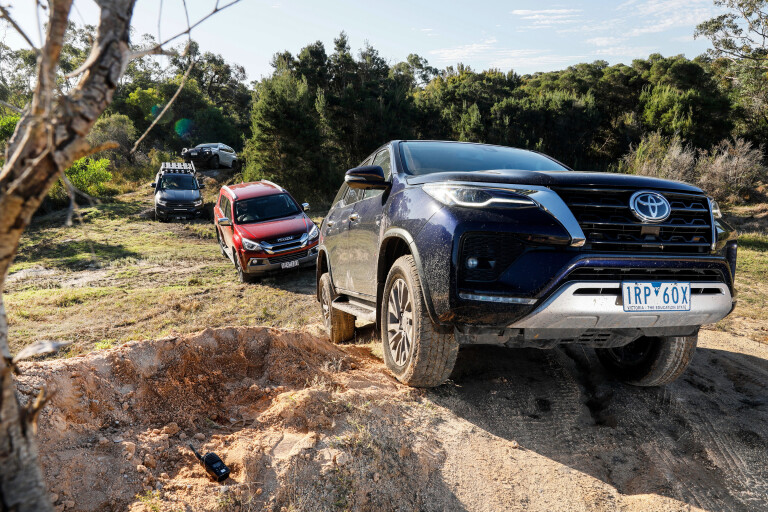
Like the corresponding HiLux, the Fortuner gained a gutsier yet more economical 2.8-litre turbo-diesel last year, along with improvements to towing capacity and steering responses. The GX opens at $49,080 before on-road costs, while ours is the swish Crusade from $61,410. That’s more than base Prado GX money.
As with the Pajero Sport and Everest but not MU-X, the Fortuner includes autonomous emergency braking (AEB), lane-departure warning with steering assist, adaptive cruise control, front and rear parking sensors, Apple CarPlay/Android Auto connectivity and digital radio, while a reverse camera, keyless entry/start, climate control, sat-nav, electric front seats, part-leather upholstery, roof rails and alloy wheels with a full-sized spare are common in all. The Toyota (with Mitsubishi) also usher in a powered tailgate and premium audio, while a chilled cool-box and – ahem – fake wood trim are sole Crusade offerings. Formica for your Fortuner, anybody?
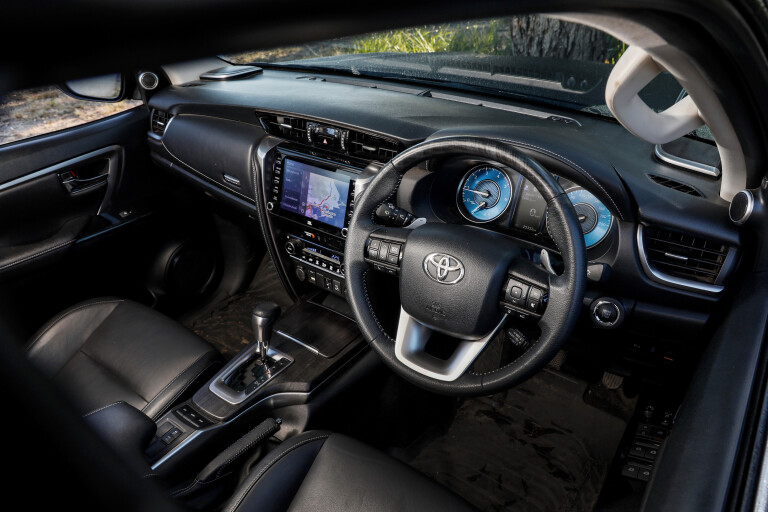
Also updated in 2020 (and coincidentally another late-2015 debutante, as the old Challenger successor) the latest Pajero Sport brings a stronger Mitsubishi family look thanks to that toothy boomerang-style chrome smile shared with its Triton pick-up twin, reshaped bumper and revised tail-lights.
There’s also uprated safety from the base $47,490 GLX five-seater up, including blind-spot monitoring and rear cross-traffic alert tech not fitted to the any other of the 4WDs tested. Revised multimedia, a redesigned centre console and electric park brake debut, along with extra convenience items such as a remote-control app for tailgate and headlight operation, exclusive to the Exceed as tested, from $57,690. That’s strong value, backed up by a conditional 10-year/200,000km warranty – or half that term if you choose not to service at a Mitsubishi dealer.

The Everest is also now approaching its sixth birthday, facelifted in 2018 with the usual headlights/grille/bumper makeovers, and is now the sole Australian-designed and engineered wagon made on Earth. Let that sink in for a moment.
Interestingly, the Ford straddles the Fortuner and Prado for pricing, kicking off from $50,090 (Ambiente 3.2L RWD five-seater), meeting its rivals here with the mid-range Trend 4WD from $60,890 and then reaching for the stars with the $73,190 Titanium Bi-Turbo 4WD. Deserved or delusional?
Our test car is one of the 450-build BaseCamp edition Trend Bi-Turbo 4WDs from – deep breath – $64,590. Emo-fied to within an inch of its grey life with tonnes of black-out make-up, there’s $6K’s worth of adventure gear (nudge bar, light bar, snorkel, towbar, roof-mounted carry bars, side steps and awning) for $2200. Trend also aligns with Crusade equipment-wise, though is alone with traffic-sign recognition.
The Everest is now approaching its sixth birthday and is now the sole Australian-designed and engineered wagon made on Earth. Let that sink in for a moment.
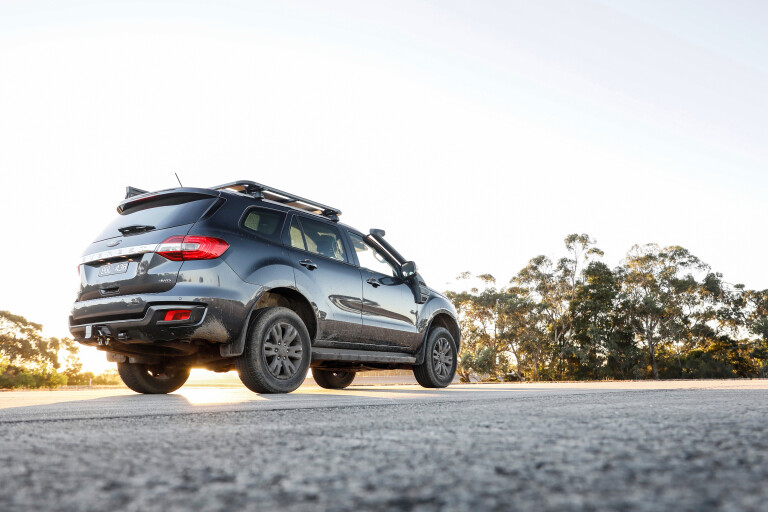
Finally, there’s the MU-X. Sorry, folks, not the box-fresh second-gen MU-X heading here later this year, but the 2013-vintage RF original (albeit updated in 2017), that grew out of the Isuzu MU (for Mysterious Utility). Fun fact: it also spawned the contemporary Colorado 7/Trailblazer, so is technically the last new Holden-ish vehicle out there. So get in quick.
Maybe that’s why sales are up 72 percent this year, growth that’s well ahead of the others. Or perhaps because the top-line LS-T AWD at $56,400 is (marginally) the cheapest of the quartet.
However, the MU-X really shows its age with a roof-mounted DVD screen but no digital radio, while vital driver-assist safety systems like AEB, lane-keep warning/assist, adaptive cruise and front parking sensors simply aren’t available. The all-new MY22 model is expected to standardise all, as it’s based on the latest (and not previous) generation D-Max pick-up.

The Isuzu starts behind the eight ball as a result, and it’s easy to stick the boot in from the moment you are first met with the laughably dated dash design, off-the-shelf multimedia and its low-fi graphics, AWOL digital speedo, cheap, sheeny finishes, slippery upholstery and persistent off-plastic reek. It can also get pretty noisy back there.
Yet, sound packaging knows no age. There’s plenty of space for a family of seven – even in the third row; the seats feel soft and comfy, with easy one-touch access thanks to a middle bench that tumbles forward and out of the way; sufficient ventilation and storage are provided – with cupholders and door pockets fitted (as per all the 4WDs tested here); vision out is good and the driving position is AOK despite – like Everest – there being no steering column reach adjustability.
The MU-X really shows its age with a roof-mounted DVD screen but no digital radio, while vital driver-assist safety systems simply aren’t available
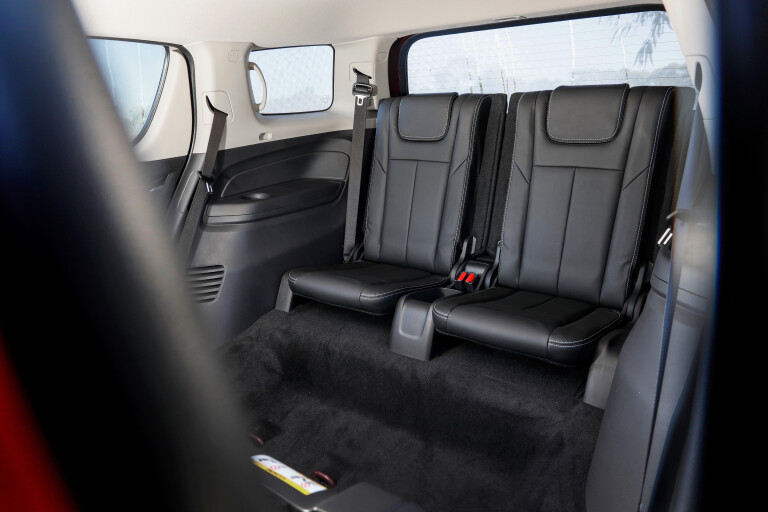
Only two years separates the Isuzu from the Mitsubishi but the latter’s cabin seems from a newer era – and a higher class. The MY20 facelift brought a bigger screen and digital instrumentation, backed up by attractive finishes and intuitive control layout. The front seats are sumptuous, there’s plenty of room for three behind on well-sculptured outboard cushions, and all expected amenities like USB ports are present.
Note, though, that the Pajero Sport’s second row bench does not slide, hampering access behind, forcing people to squeeze past the reclinable backrest’s narrow aperture; and while the third row’s also recline and there’s a useful amount of kneeroom, the cushion feels thin, the suspension is jolty and there’s too much tyre roar.

Amongst this lot, the Fortuner’s packaging feels… compromised, with a narrow-body look and feel that betrays its ageing IMV HiLux-based architecture; occupants sit noticeably closer to each other. The third-row passengers miss out on cupholders, overhead vents and USB ports, the cushions are firmest, the ride is hardest, there’s also excessive noise intrusion and access back there is the most difficult. Plus, the twin seats fold out into the sides, reducing cargo capacity, rather than in the floor as per the others – a strange layout.
Up front, the bulky dash includes two gloveboxes and it’s easy to figure out all the switchgear; the big screen is a cinch to use and the seats are supportive enough. The smallest of the quartet, it’s best to consider the Fortuner a 5+2-seater.
Only two years separates the Isuzu from the Mitsubishi but the latter’s cabin seems from a newer era – and a higher class
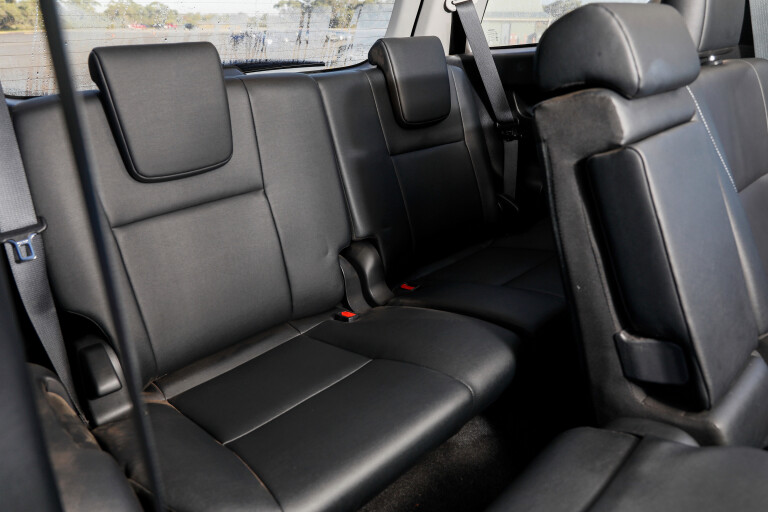
Though feeling substantially wider, the Everest’s third row suffers because entry/egress is limited by the middle row seatings’ inability to tumble forward; it’s also pretty cramped for adults and there are no USB ports. But the seating is far comfier, it’s quietest and the ride is softest of the group. The same also applies to the middle row, which benefits from the largest rear doors, while the front seats are the best for support.
The Trend’s dash may be very familiar by now, but it still works exceedingly well, with excellent controls, great ventilation, heaps of storage and a very friendly (if dated looking) multimedia system. It doesn’t seem as upmarket as the Pajero Sport’s, but is miles more appealing than those of the Toyota or Isuzu. From a functionality and practicality perspective, the Everest still shines.
The Ford is also the only 4WD here to offer a choice of two powertrains.

Ours is the 157kW/500Nm 2.0-litre four-cylinder Bi-Turbo diesel instead of the hoary old 143kW/470Nm 3.2-litre five-pot turbo-diesel, coupled to a slick 10-speed (rather than six-speed) auto. It might be down on capacity, but this is an impressively strong powertrain – once you’re on the move.
Off the line, the portly (from 2387kg) Everest feels slowest, trailing the rest and barely keeping the actual tardiest (Pajero Sport) in its sights right up to 60km/h; but with the twin turbos blowing in strongly, the Ford then pulls the hardest, smoothest and quietest of the quartet, crossing the 100km/h mark in 10.6s, and is pipped only by the Fortuner past 120km/h. Keep in mind that our BaseCamp extras impede aerodynamics, which hindered top speed.
Some testers have noted that the transmission can feel busy or indecisive by having to slice through so many ratios, but in our experience, the driver-adaptive tech comes into play seamlessly. This is the most refined powertrain here.

As mentioned, the 2155kg Fortuner is easily the fastest. Aided by the highest power-to-weight ratio, a big new turbo and smartly spaced six forward speeds, its 150kW/500Nm 2.8-litre four-pot turbo is the group’s tearaway racer, beating the Everest by at least a 0.3s interval at every increment. Toyota’s done a great job extracting such punchy performance, and without sacrificing civility either – except when the particulate filter purge kicks in like a big old noisy generator.
The wooden spoon is a tie-up between the 130kW/430Nm 3.0-litre Isuzu and 133kW/430Nm 2.4-litre Mitsubishi, which are within 0.1s of each other at virtually every marker – and that’s no surprise, given they both have similar (at 60kW and 63kW per tonne respectively) power-to-weight ratings.
But while the end results are similar, the way they go varies. The 2110kg Pajero Sport lives up to its name by being a revvy little unit, feeling friskiest when the engine is working hard and relying on its close-ratio eight-speed auto to shuffle through the ratios without fuss; in contrast, the Gloria Marshall’d 2062kg MU-X is a slogger, and quite loud to boot, relying on its extra 600cc capacity for a dollop of low-down pull. And once momentum is achieved, it maintains the muscle as speeds rise.
Off the line, the portly Everest feels slowest, trailing the rest and barely keeping the actual tardiest – the Pajero Sport – in its sights

All four 4WDs have impressive average fuel consumption claims, with the Everest’s being the lowest for the longest distances between refills – 7.0L/100km, with over 1140km possible due to its 80L tank. At the other end of the scale is the MU-X’s circa-830km range, as a result of its bigger thirst (7.9L/100km) and 15L-smaller diesel reservoir.
In truth, there really isn’t that much in it between them against the clock – but away from the flat, smooth drag strip, the differences are far more telling… and definitive.
All four are fundamentally light and easy to drive by people across the height and size spectrum, belying their sheer bulk to be amenable urban family haulers as well as weekend lifestyle getaways. Given they feature body-on-frame construction, lockable low-range 4x4 engineering and ample ground clearance for light-to-medium bush bashing, they’re all impressive all-round performers.
But focussing on their on-road dynamics and comfort, only one model here can do it all.

Inevitably, the MU-X isn’t it. Superficially, you might be impressed by the Isuzu’s eager steering, which makes it feel lighter through corners than its size suggests. And there’s plenty of grip too, with minimal body lean. However, even at moderate speeds, the handling can feel nervous, the ride is jittery and the amount of noise coming through really betrays the Isuzu’s age. The electronics cut power mid-corner with tiresome regularity and the steering rack rattles too, like a cheap set of dentures. Which might be an apt metaphor for the MU-X’s overall on-road behaviour.
Then it’s a big step up to the Fortuner. Already the fleetest of the foursome, the chassis engineers have clearly set this up for handling agility and composed roadholding, thanks to smooth and progressive steering, backed up by fine body control – making it unexpectedly fun to throw around, in a scrappy sort of way.
But, you can sense a ‘but’ coming on, right? Your butt’s already on it, suffering from the unyielding ride that rarely settles down. Slow or fast, over smooth or rough, the Toyota will have its occupants shaken as surely as the driver is stirred. Not good enough.
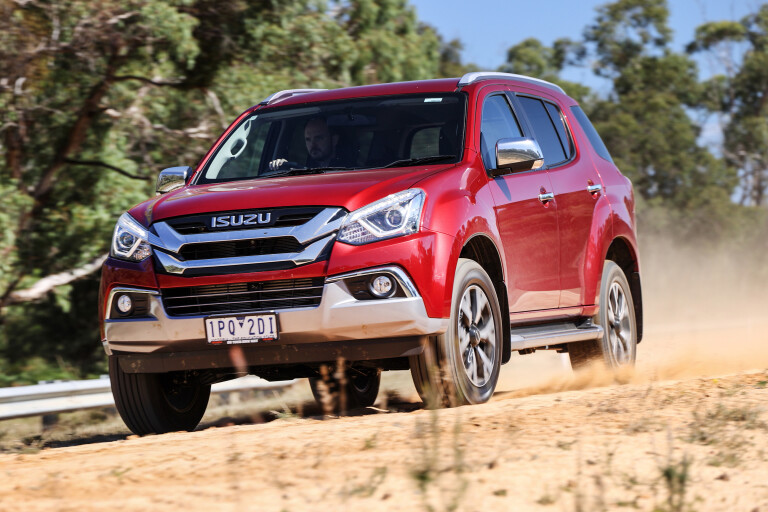
The opposite applies to the squidgy Mitsubishi, due to its engineers emphasising comfort over agility. In concert with the sumptuous seating, the suspension is soft, absorbing bumps left, right and centre – and that too describes how loosely the body feels as it leans and pitches compared to the rest. That said, we applaud the diamond brand’s priorities, because most occupants will gladly trade the harshness and at-times discomfort of the Toyota and Isuzu for smooth and relaxed transportation.
Ultimately, there’s nothing athletic about the Pajero Sport’s remote, feel-free steering or handling that is tuned for safe but ultra-dull proficiency. It’s easy to achieve a balanced flow through a series of corners, but way before any limits are reached, the ESC will abruptly end play, ensuring the driver will never be having fun.

This is where the Everest is an absolute knockout, displaying next-level sophistication and finesse the others cannot hope to match. My notes on the steering (“wonderfully talkative and flowing”), handling (“car-like”), roadholding (“exceptional”), suspension (“supple”) and emergency braking distance (“best of the lot”) all spell it out: The Ford is leagues ahead. Keener drivers will feel nourished as surely as occupants will appreciate how plush and isolated the ride is.
As we said at the beginning, the Everest and Ranger represent the end of a very long road of mass-produced Australian-engineered vehicles, and while it may not be as cheap as the MU-X, opulent as the Pajero Sport or fast as the Fortuner, it is by far the best in class. This is an achievement we can be proud of.

There’s a clear space between it and second-placed Pajero Sport, which puts in a good, honest showing by dint of its value pricing, passenger-first comfort engineering and appealing ownership protection. Too bad it’s such a dreary drive.
Just behind that comes the Fortuner, which – performance aside – shows its age and limitations in too many areas, while the group’s actual geriatric, the MU-X, surprisingly puts up a fair fight with low pricing and smart packaging, but ultimately is just too creaky to properly compete. We have high hopes for the MY22 model.
The Ford’s resounding victory reminded us of two things. Firstly, it smashes rigid expectations and blurs lines with its pan-category capabilities. And, secondly, as a result, there isn’t a more-accomplished body-on-frame 4WD wagon on this continent.
Everest by name, Everest by nature.
Interior Comparison
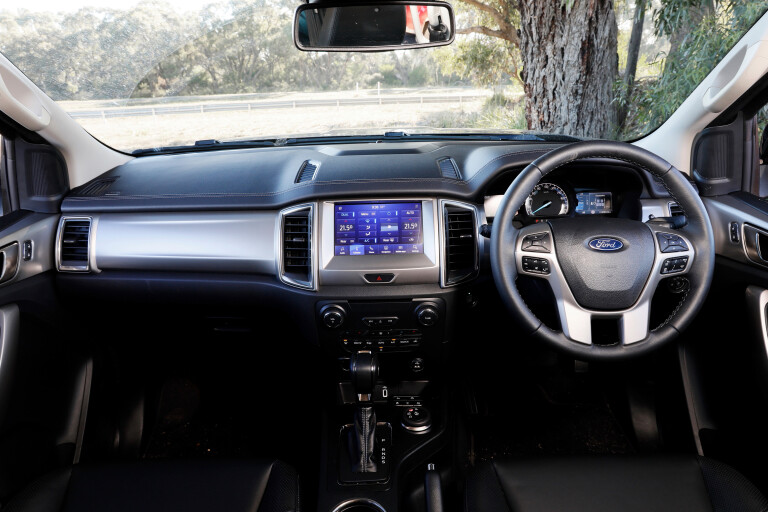
Ford Everest
Shared with the Ranger, the Everest’s dash is dated but smart and functional, with user-friendly SYNC3 multimedia, supportive seating, excellent storage and strong packaging for taller people up front and in the second row. But there’s no telescopic steering adjustment while third-row entry/egress isn’t elegant and space back there is tight. Cargo volume is 249L with all seats erect, 876L in five-seat mode and 1796L with two-seater configuration. Braked towing capacity is rated at 3100kg, ground clearance is 227mm.

Isuzu MU-X
The MU-X cabin feels old and cheap, and steering is tilt-only, though there’s plenty to recommend, including comfy seats, heaps of space, the oddball circular ventilation controller is quite nice to use and third-row access is easiest of quartet. But doors don’t open up very wide and there’s too much noise intrusion. Cargo volume is 235L with all seats up, 878L in five-seat mode and 1830L with two-seater configuration, beating Everest. Braked towing capacity is rated at 3000kg, ground clearance is 230mm.
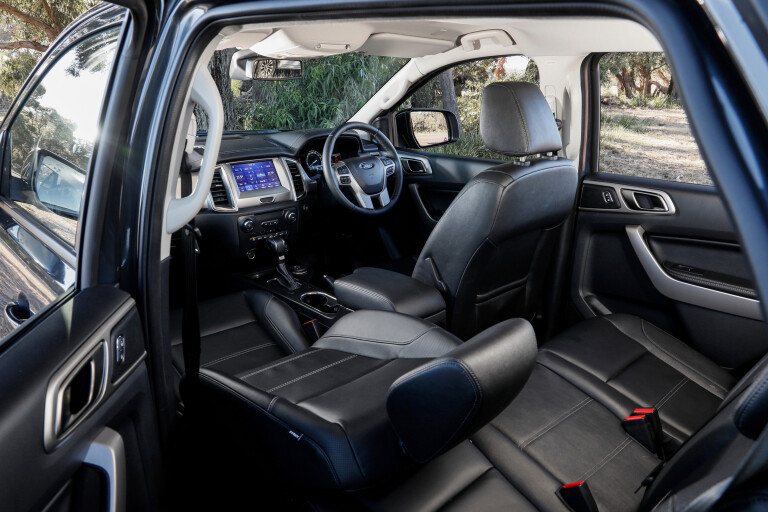
Mitsubishi Pajero Sport
Updated digital instrumentation helps boost the Paj Sport cabin’s luxury feel, and also scores with soft seats, lots of space and heaps of useful features. But third-row access isn’t great, the seats are uncomfortable and there’s too much noise coming in. Second-row child-seat tethers impede third-row space because of ceiling hooks. Cargo volume trails the best, with 131L in seven-seat mode, 502L with the third-row folded and just 1488L with rows two and three flattened. Braked towing capacity is rated at 3100kg, ground clearance is 218mm.
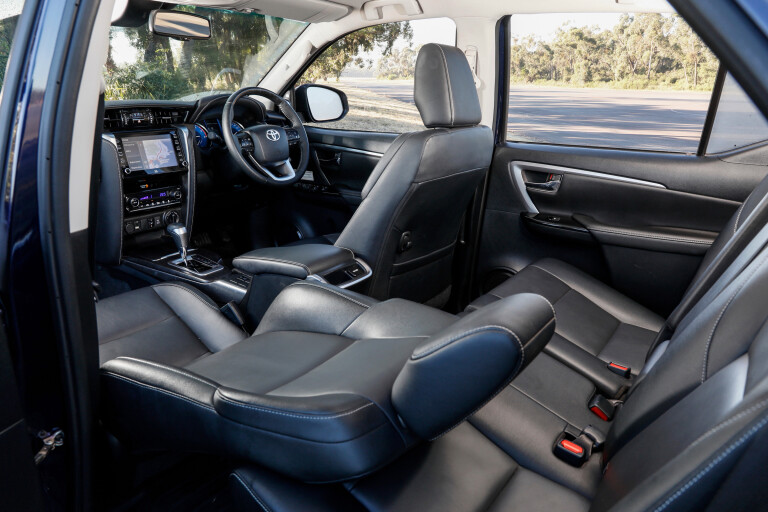
Toyota Fortuner
The Fortuner’s dash looks dated and bulky but is typical-Toyota practical, and benefits from revised instrumentation and multimedia. Seating is fine, but the whole vehicle feels narrower than the rest. Rather than folding into the floor, the twin third-row seats fold up into the sides, eating into luggage space. Cargo volume is 200L with all seats up, 716L in five-seat mode and a disappointing 1080L with two-seater configuration. Braked towing capacity is rated at 3100kg, ground clearance is 216mm.
Verdict
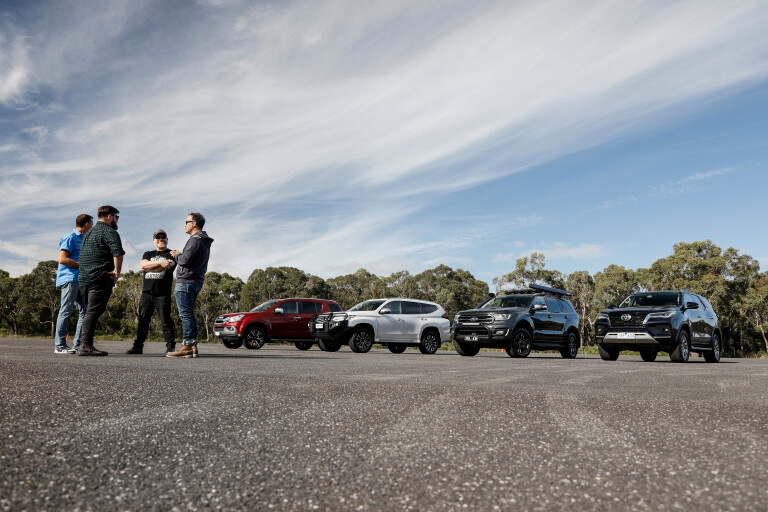
1st - Ford Everest
Score: 8.5/10
Like: Outstanding ride and handling, polished powertrain, comfort, space, design
Dislike: Expensive, dated dash, no telescopic steering, difficult third-row access
Warranty: 5yr/unlimited km. Service interval: 12 months, 15,000km. Glass’s 3-year resale: 58%. AAMI Insurance: $958
*Includes BaseCamp special edition with nudge bar, LED light bar, snorkel, towbar, carry bars, Pioneer platform and Sunseeker awning ($2200), Meteor Grey prestige paint ($650)
2nd - Mitsubishi Pajero Sport
Score: 7.0/10
Like: Value pricing, conditional 10-year warranty, comfy ride, plush interior
Dislike: Dull steering, noisy interior, excessive body lean through corners
Warranty: 5yr/unlimited km. Service interval: 12 months, 15,000km. Glass’s 3-year resale: 60%. AAMI Insurance: $914
3rd - Toyota Fortuner
Score: 6.5/10
Like: Gutsy performance, sharp handling, Toyota dependability, build quality
Dislike: Dreary dash, narrow cabin, jittery ride, cramped and noisy third row
Warranty: 5yr/unlimited km. Service interval: 12 months, 15,000km. Glass’s 3-year resale: 57%. AAMI Insurance: $981
* Includes premium paint ($600)
4th - Isuzu MU-X
Score: 5.5/10
Like: Smart packaging, sharp pricing, easy-access third-row, six-year warranty
Dislike: Lack of driver-assist safety, stiff ride, cheap-looking cabin, noise intrusion
Warranty: 6yr/150,000km. Service interval: 12 months/15,000km. Glass’s 3-year resale: 54%. AAMI Insurance: $1018
* Includes Magnetic Ted mica paint ($500)
Specifications

Performance figures
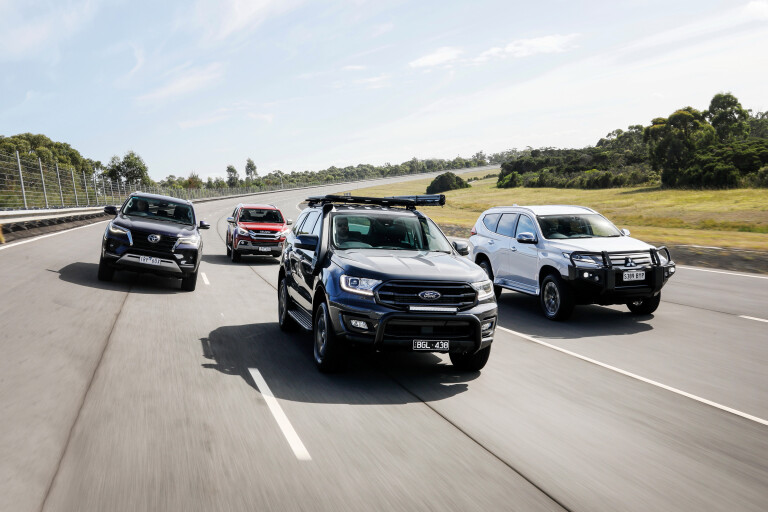
Track: Warm, dry
Temp: 23ºC
Driver: Byron Mathioudakis

COMMENTS